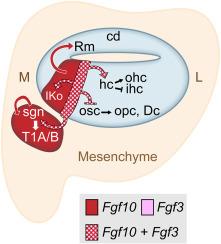Early and transient requirements for FGFR2b/1b ligands in cochlear sensory and neural cell subtype differentiation
IF 2.1
3区 生物学
Q2 DEVELOPMENTAL BIOLOGY
引用次数: 0
Abstract
We probed the roles of FGFR2b/1b signaling in mid-gestation cochlear development by inducing dnFGFR2b, a ligand trap that sequesters FGF3 and FGF10. Analyses following E11.5-E18.5 induction showed that FGFR2b/1b ligands are required for normal hair cell numbers, to repress inner hair cell differentiation in the lateral organ of Corti and to promote outer hair cell differentiation. FGFR2b/1b ligands also repress outer support cell numbers and promote differentiation of outer pillar cells and Deiters' cells. Finally, these ligands also promote normal cochlear ganglion size and morphology as well as differentiation of CALB2-positive spiral ganglion neuronal subtypes. Delaying the start of dnFGFR2b expression to successive days after E11.5 revealed a critical period of E11.5-E13.5 for FGFR2b/1b signaling in sensory development and of E11.5-E14.5 in ganglion development. Strikingly, even transient induction of dnFGFR2b from E11.5-E12.5 was sufficient to largely recapitulate the phenotypes seen following long-term induction, suggesting that some of the key FGFR2b/1b ligand-dependent events controlling cochlear cell subtype differentiation occur long before such differentiation is evident, and suggesting a new window within which to search for regulators of cochlear differentiation.

FGFR2b/1b配体在耳蜗感觉和神经细胞亚型分化中的早期和瞬时需求
我们通过诱导dnFGFR2b(一种隔离FGF3和FGF10的配体陷阱),探讨了FGFR2b/1b信号通路在妊娠中期耳蜗发育中的作用。E11.5-E18.5诱导后的分析表明,FGFR2b/1b配体是正常毛细胞数量、抑制Corti外侧器官内毛细胞分化和促进外毛细胞分化所必需的。FGFR2b/1b配体还能抑制外支持细胞的数量,促进外柱细胞和deiter细胞的分化。最后,这些配体还能促进正常耳蜗神经节的大小和形态,以及calb2阳性螺旋神经节神经元亚型的分化。将dnFGFR2b的表达延迟到E11.5之后的连续几天,揭示了FGFR2b/1b信号在感觉发育中的E11.5- e13.5和在神经节发育中的E11.5- e14.5的关键时期。引人注目的是,即使是E11.5-E12.5短暂诱导的dnFGFR2b也足以在很大程度上再现长期诱导后所见的表型,这表明控制耳蜗细胞亚型分化的一些关键FGFR2b/1b配体依赖事件早在这种分化明显之前就发生了,并提示了寻找耳蜗分化调节因子的新窗口。
本文章由计算机程序翻译,如有差异,请以英文原文为准。
求助全文
约1分钟内获得全文
求助全文
来源期刊

Developmental biology
生物-发育生物学
CiteScore
5.30
自引率
3.70%
发文量
182
审稿时长
1.5 months
期刊介绍:
Developmental Biology (DB) publishes original research on mechanisms of development, differentiation, and growth in animals and plants at the molecular, cellular, genetic and evolutionary levels. Areas of particular emphasis include transcriptional control mechanisms, embryonic patterning, cell-cell interactions, growth factors and signal transduction, and regulatory hierarchies in developing plants and animals.
 求助内容:
求助内容: 应助结果提醒方式:
应助结果提醒方式:


